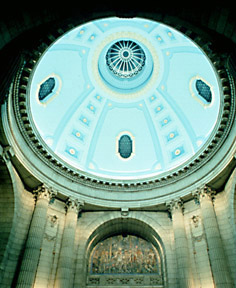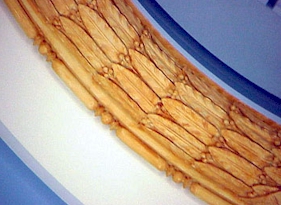The Rotunda
 The antechamber at the head of the grand staircase provides a formal approach to the legislative chamber. Four pairs of Corinthian columns rise from the floor to the cornice surrounding the base of the dome. The floor of the dome rotunda is Tennessee marble bordered with black Vermont and verde antique marble. The design around the floor is a continuous modified Grecian key, symbolic of the eternal quest for knowledge. The Grecian key, as well as other symbols of eternity, such as the wave or running dog pattern and the circle motif, are found throughout the interior and the exterior of the building. Also repeated throughout the building is the number 13, as seen in the number of bulbs in the Roman Standard Lamps that help light the Rotunda. Some believe the number symbolized luck for the ancient Egyptians. Others believe the number holds symbolic importance to freemasons, whose members were, no doubt, involved in the design and construction of the Legislative Building. Yet others believe such repetition is because ancient Romans felt the number 13 to be bad luck and hoped that honouring the number was the way to escape its curse. Most agree it is an intriguing but unsolvable mystery. Over the main entrance to the legislative chamber is a mural depicting Canadian army life in France during the First World War. Painted by Frank Brangwyn of London, England, one of Europe's finest muralists, the mural portrays the carnage and tragic sacrifice of war but bright flowers in the foreground herald the coming of peace. |
 In the middle of the floor, an Italian marble balustrade surrounds the Pool of the Black Star on the floor of the level below, a representation of the altars of the ancient Greeks. |

